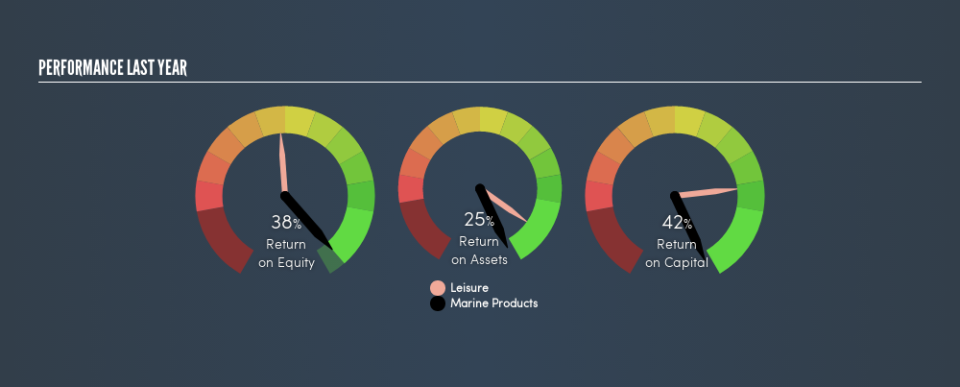Is Marine Products Corporation’s (NYSE:MPX) 42% ROCE Any Good?

Want to participate in a short research study? Help shape the future of investing tools and you could win a $250 gift card!
Today we are going to look at Marine Products Corporation (NYSE:MPX) to see whether it might be an attractive investment prospect. Specifically, we're going to calculate its Return On Capital Employed (ROCE), in the hopes of getting some insight into the business.
First up, we'll look at what ROCE is and how we calculate it. Second, we'll look at its ROCE compared to similar companies. Then we'll determine how its current liabilities are affecting its ROCE.
What is Return On Capital Employed (ROCE)?
ROCE measures the 'return' (pre-tax profit) a company generates from capital employed in its business. Generally speaking a higher ROCE is better. Overall, it is a valuable metric that has its flaws. Renowned investment researcher Michael Mauboussin has suggested that a high ROCE can indicate that 'one dollar invested in the company generates value of more than one dollar'.
So, How Do We Calculate ROCE?
Analysts use this formula to calculate return on capital employed:
Return on Capital Employed = Earnings Before Interest and Tax (EBIT) ÷ (Total Assets - Current Liabilities)
Or for Marine Products:
0.42 = US$35m ÷ (US$111m - US$28m) (Based on the trailing twelve months to March 2019.)
So, Marine Products has an ROCE of 42%.
View our latest analysis for Marine Products
Is Marine Products's ROCE Good?
ROCE is commonly used for comparing the performance of similar businesses. Marine Products's ROCE appears to be substantially greater than the 16% average in the Leisure industry. We consider this a positive sign, because it suggests it uses capital more efficiently than similar companies. Setting aside the comparison to its industry for a moment, Marine Products's ROCE in absolute terms currently looks quite high.
We can see that , Marine Products currently has an ROCE of 42% compared to its ROCE 3 years ago, which was 22%. This makes us think about whether the company has been reinvesting shrewdly. You can click on the image below to see (in greater detail) how Marine Products's past growth compares to other companies.
It is important to remember that ROCE shows past performance, and is not necessarily predictive. ROCE can be misleading for companies in cyclical industries, with returns looking impressive during the boom times, but very weak during the busts. ROCE is, after all, simply a snap shot of a single year. What happens in the future is pretty important for investors, so we have prepared a free report on analyst forecasts for Marine Products.
Marine Products's Current Liabilities And Their Impact On Its ROCE
Current liabilities include invoices, such as supplier payments, short-term debt, or a tax bill, that need to be paid within 12 months. Due to the way the ROCE equation works, having large bills due in the near term can make it look as though a company has less capital employed, and thus a higher ROCE than usual. To counter this, investors can check if a company has high current liabilities relative to total assets.
Marine Products has total assets of US$111m and current liabilities of US$28m. Therefore its current liabilities are equivalent to approximately 25% of its total assets. This is quite a low level of current liabilities which would not greatly boost the already high ROCE.
Our Take On Marine Products's ROCE
Low current liabilities and high ROCE is a good combination, making Marine Products look quite interesting. There might be better investments than Marine Products out there, but you will have to work hard to find them . These promising businesses with rapidly growing earnings might be right up your alley.
If you like to buy stocks alongside management, then you might just love this free list of companies. (Hint: insiders have been buying them).
We aim to bring you long-term focused research analysis driven by fundamental data. Note that our analysis may not factor in the latest price-sensitive company announcements or qualitative material.
If you spot an error that warrants correction, please contact the editor at editorial-team@simplywallst.com. This article by Simply Wall St is general in nature. It does not constitute a recommendation to buy or sell any stock, and does not take account of your objectives, or your financial situation. Simply Wall St has no position in the stocks mentioned. Thank you for reading.

 Yahoo Finance
Yahoo Finance 
